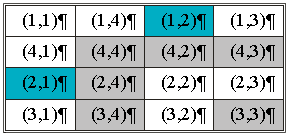Steganographic method with code control of information embedding based on multi-level code words
DOI:
https://doi.org/10.3103/S0735272723040052Keywords:
steganography, discrete cosine transform, Walsh-Hadamard transform, code control of information embedding, selectivityAbstract
Effective steganographic methods are an integral part of modern information security systems. At the same time, one of the key requirements for modern steganographic methods, taking into account their needed implementation on mobile and IoT devices, is their low resource consumption maintaining high perception reliability, throughput, and resistance to attacks against the embedded message. The steganographic method with code control of additional information embedding using multi-level code words is presented in this work. A new synthesis approach of multi-level code words with a high selectivity coefficient is developed. It allows us to ensure the specified properties of steganographic messages. Sets of multi-level code words of practically valuable sizes are synthesized and studied. Experimental studies of the effectiveness of the steganographic method with embedding code control based on the presented multi-level code words are conducted. They ensure a high level of its resistance to attacks against the embedded message, by compression, noise superimposing, and blurring, while ensuring sufficient bandwidth and perception reliability in practice.
References
- A. A. Kobozeva, V. A. Horoshko, Information Security Analysis, [in Russian]. Kiev: Izd. GUIKT, 2009.
- A. K. Bairagi, R. Khondoker, R. Islam, “An efficient steganographic approach for protecting communication in the Internet of Things (IoT) critical infrastructures,” Inf. Secur. J. A Glob. Perspect., vol. 25, no. 4–6, pp. 197–212, 2016, doi: https://doi.org/10.1080/19393555.2016.1206640.
- I. Hussain, M. C. Negi, N. Pandey, “Security in ZigBee using steganography for IoT communications,” in System Performance and Management Analytics, 2019, pp. 217–227.
- D. Stanescu, V. Stangaciu, M. Stratulat, “Steganography on new generation of mobile phones with image and video processing abilities,” in 2010 International Joint Conference on Computational Cybernetics and Technical Informatics, 2010, pp. 343–347, doi: https://doi.org/10.1109/ICCCYB.2010.5491253.
- Z. Li, M. Zhang, J. Liu, “Robust image steganography framework based on generative adversarial network,” J. Electron. Imaging, vol. 30, no. 02, 2021, doi: https://doi.org/10.1117/1.JEI.30.2.023006.
- S. Wang, N. Zheng, M. Xu, “A compression resistant steganography based on differential Manchester code,” Symmetry, vol. 13, no. 2, p. 165, 2021, doi: https://doi.org/10.3390/sym13020165.
- Z. Zhu, N. Zheng, T. Qiao, M. Xu, “Robust steganography by modifying sign of DCT coefficients,” IEEE Access, vol. 7, pp. 168613–168628, 2019, doi: https://doi.org/10.1109/ACCESS.2019.2953504.
- K. S. Babu, K. B. Raja, K. U. M. Rao, K. A. Rashmi, K. R. Venugopal, L. M. Patnaik, “Robust and high capacity image steganography using SVD,” in IET-UK International Conference on Information and Communication Technology in Electrical Sciences (ICTES 2007), 2007, pp. 718–723, doi: https://doi.org/10.1049/ic:20070706.
- M. A. Melnik, “Compression-resistant steganographic algorithm,” Inf. Secur., vol. 2, no. 8, pp. 99–106, 2012.
- C. C. Chang, C. C. Lin, Y. S. Hu, “An SVD oriented watermark embedding scheme with high qualities for the restored images,” Int. J. Innov. Comput. Inf. Control, vol. 3, no. 3, pp. 609–620, 2007.
- O. Evsutin, A. Melman, R. Meshcheryakov, “Digital steganography and watermarking for digital images: A review of current research directions,” IEEE Access, vol. 8, pp. 166589–166611, 2020, doi: https://doi.org/10.1109/ACCESS.2020.3022779.
- Z. Bao, Y. Guo, X. Li, Y. Zhang, M. Xu, X. Luo, “A robust image steganography based on the concatenated error correction encoder and discrete cosine transform coefficients,” J. Ambient Intell. Humaniz. Comput., vol. 11, no. 5, pp. 1889–1901, 2020, doi: https://doi.org/10.1007/s12652-019-01345-8.
- S. Bhattacharyya, S. Mondal, G. Sanyal, “A robust image steganography using Hadamard transform,” in International Conference on Information Technology in Signal and Image Processing, 2013, pp. 416–426.
- J. Tao, S. Li, X. Zhang, Z. Wang, “Towards robust image steganography,” IEEE Trans. Circuits Syst. Video Technol., vol. 29, no. 2, pp. 594–600, 2019, doi: https://doi.org/10.1109/TCSVT.2018.2881118.
- O. V. Kostyrka, “Analysis on the benefits of spatial domain of cover image for steganography transformation,” Informatics Math. Methods Simul., vol. 3, no. 3, pp. 275–282, 2013.
- A. Kobozeva, A. Sokolov, “Robust steganographic method with code-controlled information embedding,” Probl. Reg. Energ., no. 4(52), pp. 115–130, 2021, doi: https://doi.org/10.52254/1857-0070.2021.4-52.11.
- A. A. Kobozeva, A. V. Sokolov, “Theoretical foundations for constructing effective codewords for the code-controlled information embedding steganographic method,” Radiotekhnika, no. 207, pp. 27–39, 2021, doi: https://doi.org/10.30837/rt.2021.4.207.02.
- I. I. Ismagilov, “An approach to ordering of systems of the Walsh discrete functions,” Radioelectron. Commun. Syst., vol. 49, no. 1, pp. 46–50, 2006, doi: https://doi.org/10.3103/S0735272706010079.
- A. Kobozeva, A. Sokolov, “Efficient coding of the embedded signal in steganographic systems with multiple access,” Probl. Reg. Energ., vol. 2, no. 50, 2021, doi: https://doi.org/10.52254/1857-0070.2021.2-50.09.
- M. I. Mazurkov, Broadband Radio Systems, [in Russian]. Odessa: Science and Technology, 2010.
- N. R. C. S. (NRCS), “United States Department of Agriculture.” https://www.nrcs.usda.gov.
- A. Westfeld, A. Pfitzmann, “Attacks on steganographic systems,” in International workshop on information hiding, 1999, pp. 61–76, uri: https://users.ece.cmu.edu/~adrian/487-s06/westfeld-pfitzmann-ihw99.pdf.


